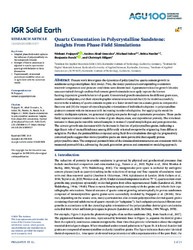Quartz Cementation in Polycrystalline Sandstone: Insights From Phase-Field Simulations
Abad Gonzalez, Andres
DOI: https://doi.org/10.1029/2019JB019137
Persistent URL: http://resolver.sub.uni-goettingen.de/purl?gldocs-11858/9322
Persistent URL: http://resolver.sub.uni-goettingen.de/purl?gldocs-11858/9322
Prajapati, Nishant; Abad Gonzalez, Andres; Selzer, Michael; Nestler, Britta; Busch, Benjamin; Hilgers, Christoph, 2020: Quartz Cementation in Polycrystalline Sandstone: Insights From Phase-Field Simulations. In: Journal of Geophysical Research: Solid Earth, Band 125, 2, DOI: 10.1029/2019JB019137.
 |
Dokument öffnen: |
Present work investigates the dynamics of polycrystalline quartz cement growth in sandstone using a multiphase-field model. First, the model parameters corresponding to common reservoir temperature and pressure conditions were determined. A parameter related to growth kinetics was ascertained through undisturbed cement growth simulations to aptly capture the known faceting-dependent growth behavior of quartz. Unrestricted growth simulations for different grain sizes, number of subgrains, and their crystallographic orientations revealed that (I) the model successfully recovers the tendency of quartz cements to grow at a faster overall rate on a coarse grain as compared to finer one and (II) the impact of crystallographic orientations of individual subgrains in polycrystalline grains on cement volume increases with increasing number of subgrains. For applying the model to realistic multigrain systems, we generated digital grain packs through a systematic procedure. These packs fairly represent natural sandstone in terms of grain shapes, sizes, and depositional porosity. The simulated textures in these packs resemble natural samples in terms of crystal morphologies and pore geometries. The cement growth rate decreases with the increase in fraction of polycrystalline grains, indicating a significant role of mutual hindrance among differently oriented overgrowths originating from different subgrains. Further, the permeabilities computed using fluid-flow simulations through the progressively cemented packs suggest that monocrystalline packs are more permeable than equally porous polycrystalline ones. The computed permeabilities of the simulated microstructures are consistent with the measured permeabilities, advocating the pack generation process and cementation modeling approach.
Statistik:
ZugriffsstatistikSammlung:
Schlagworte:
multiphase-field modelingquartz cementation
digital grain packs
polycrystalline grains
porosity
permeability
This is an open access article under the terms of the Creative Commons Attribution License, which permits use, distribution and reproduction in any medium, provided the original work is properly cited.

